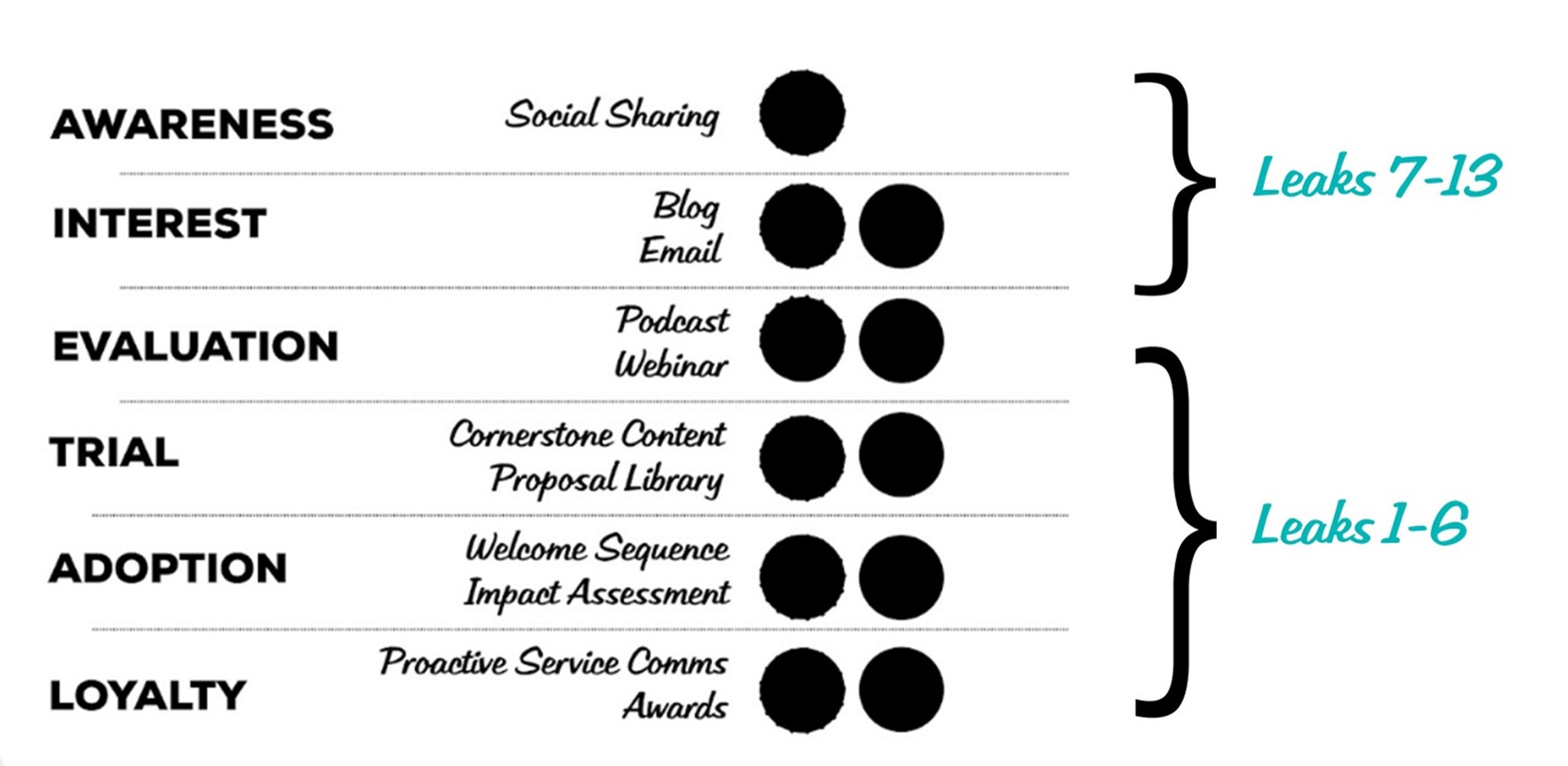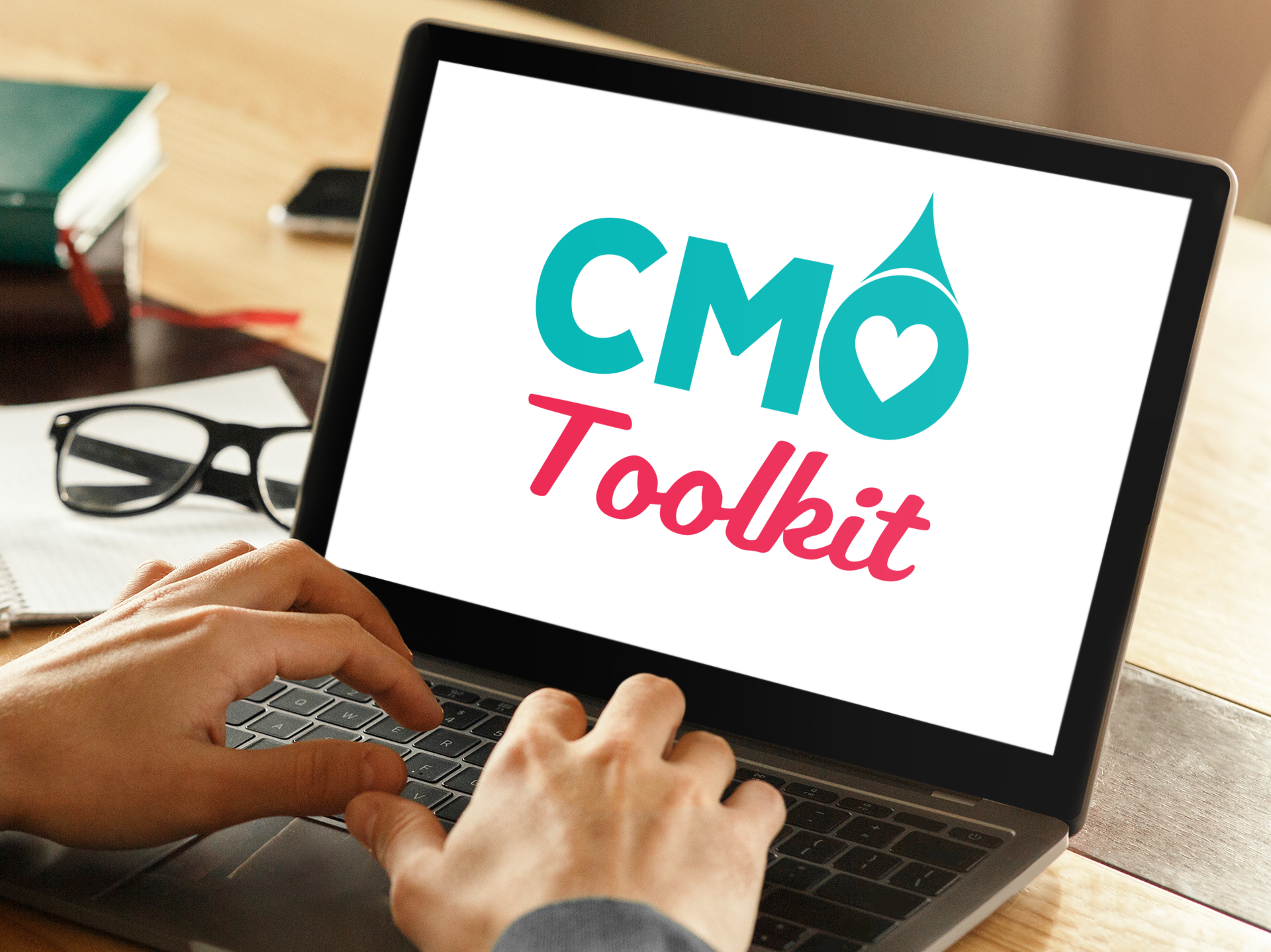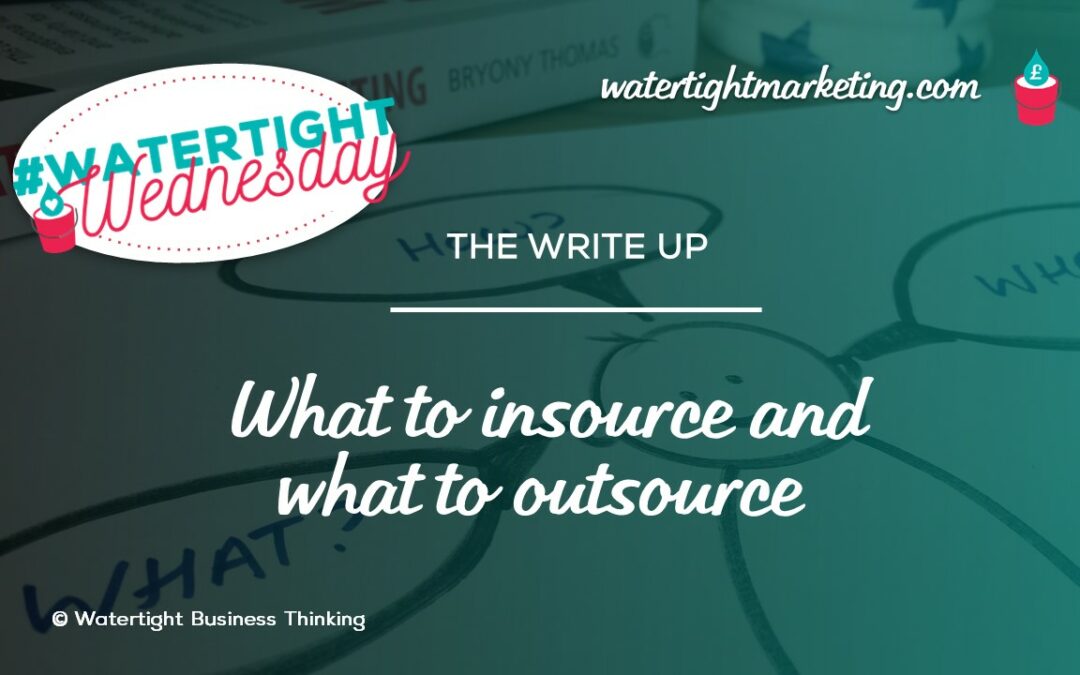Reading Time: 10 Minutes
As any in-house marketer will tell you, there will come a time when you might need to use external specialists. There are all sorts of factors involved in deciding what to keep in-house and what might need outsourcing. It might be that you don’t have the capacity in your team and it’s a short-term fix. It might be because you need the knowledge and breadth of experience that outside experts bring. We discussed some of the challenges and thinking involved in this decision at this month’s roundtable. ~ Rachael Wheatley, Master Practitioner | Watertight Marketing
Listen to the session podcast here
56-minute roundtable discussion on what skills a marketing director needs.
We kicked things off by looking at Watertight’s ‘stable table’, where we picture the Four Flow Foundations as the legs of a table. On the left hand side are the strategic foundations: The Right Work and Maintaining Momentum. On the right hand side are the operational foundations: Balanced Routine and Baseline Rhythm.
The Board’s input on marketing is mainly on the strategic side; the marketing team’s input is mainly on the operational side. Your senior marketer is the bridge between the two, translating vision, values, goals and the business plan into a marketing operation.

The sequence for insourcing marketing skills
The sequence for building a marketing capability in-house is:
- Ensure the Board know enough about marketing to be able to recruit a senior marketer and properly utilise them;
- Recruit a senior marketer, a generalist to bridge the gap between strategy and operations;
- Then recruit more junior marketer or outsource specialist suppliers.
We have seen it happen in a different order, with juniors being recruited before a senior marketer. Depending on the marketing maturity of the Board, this can work. For instance, if you have marketing-savvy MD or CEO who has sufficient experience to manage a more junior marketer and/or those outsourced specialists.
It’s the operations which are most successfully outsourced
The strategic side is almost never successfully outsourced. The operational side is, usually once the senior marketer is in place.
There are exceptions to this if a seasoned marketer comes in as an outsourced marketing director where they work with company for a while. For this to work:
- They need to work very closely with an in-house team – including the board. They provide that bridge between the strategy and operations.
- They need to have access to a marketing doer in-house or have a relationship with an agency who does the tactical work.
It’s rarely a long-term solution. At some point, the business is likely to need to recruit for that senior position. In a way, that would be a measure of success, that you work with a company to the point where they need that position filled in-house.
Outsourcing is a good solution if you need depth
When deciding whether to insource or outsource, another consideration is breadth versus depth. The red dots in the diagram below represent Board level: they need to know enough about marketing to see how it can be used as a strategic growth lever but not chapter and verse on the detail.

The blue dots represent the marketing team at different levels (senior and junior). These tend to be marketing generalists who have a good understanding of marketing planning and and which marketing tools to use, but not necessarily a deep understanding of those same tools.
The yellow dots denote marketing experts who have deep knowledge of different areas of marketing: SEO, website development, PR, content creation, etc. You outsource to specialists for depth and this is where it is usually done successfully. Adverts that ask for marketing and design qualifications are akin to looking for an architect who also does the plastering. These are not interchangeable skills, nor even likely to be within the same individual.
Resourcing for marketing
One of the key tools that we use in Watertight Marketing is the Touchpoint Leak Assessment. These are the 13 ways in which customers can exit their buying decision. Leaks 1-6 span the marketing that engages with warm prospects and existing clients. Leaks 7-13 refer to the marketing that raises awareness and piques people’s interest.
You could outsource any or all of the marketing which helps to plug these leaks or supports the customer at any point in their decision journey.

However, even if you did so, you would still need someone in-house to have a good understanding of the company and their customers and be able to brief and manage those outsourced suppliers. Some larger businesses have their own in-house agency or marketing services team who can provide much of the expertise needed to support these marketing activities.
What is important to remember is that there is no point in outsourcing any activity and spending your precious budget on marketing to generate awareness and interest if you have leaks further down. Plug these first; they can often be done with the knowledge, skills and capacity you have in-house.
Three considerations in deciding whether to insource or outsource
There are three things to consider in your decision:
- Whether you have the time to do it yourself.
- Whether you have the budget to outsource.
- Whether you have the knowledge or depth of expertise to insource.
The more you have all three – time, money and knowledge/skills – the more choice you have! If you don’t have the time or knowledge/skills and you definitely want those marketing activities done, you’ll need to outsource. You could do this with hands-on support on a short-term basis (e.g. for a particular project or campaign); on an on-going basis (e.g. outsourced to freelancers); or to improve or increase internal skills by your team working alongside outsource experts,
If you don’t have the budget, you could try and negotiate with suppliers such that the size and shape of what you outsource is within budget. Or (if you have the time) you could develop your in-house knowledge.
But what if have none of these three things, what do you do? At some point, to progress your marketing, you need to take a decision and chose one: develop knowledge and do it in-house, set aside time or invest in an outsourced specialist even if it’s limited in time or scope.
What factors do clients use to help them decide and when does it work best?
Cheryl Crichton : It’s a good question. I’ve worked with big and little companies and both in-house and for agencies so I’ve seen it from different angles. One of the most common reasons for outsourcing is when a big project lands or you win a big new client and suddenly you haven’t got enough people to do what’s needed. You might want to outsource some of what your team are working on themselves or give them support for that. Similarly, it might take you longer to do something than outsourcing it to experts; there can be a false economy to keep it in-house and outsourcing it might get a better return.
Rachael Wheatley: That’s an interesting point. Sometimes it’s hard to let go and understand that others could do something better than you or it might not be the best use of your time.
Cheryl Crichton: The other instance where I’ve seen it hasn’t worked is where it’s been outsourced outside your native country. So, if you’re working in the UK and you want a website done, there’s a lot of marketing from providers in other countries. In my experience, that often doesn’t work well because there’s a language or time barrier. Do choose your outsourced providers carefully, get some recommendations and make sure they come with good credentials. Don’t be tempted to go with the cheapest – it can come back to bite you!
Katherine Hamilton: We have quite a large marketing and branding team overall. But we’ve now got quite a lot of junior members in the team. Their experience isn’t necessarily matching the pace and the scale that we need. So we were looking at outsourcing specialist talent. Because we work across different markets, one of which is in North America with a quite specialist audience, having that in-house knowledge of the market is really important. But it feels like a blocker in getting good outsourced talent in having to catch them up with market knowledge, but also still looking for the specialist senior skill sets that we need.
Rachael Wheatley: It’s quite difficult to outsource generalist marketing or specific market knowledge. It’s much easier to say, we need someone to develop content, for instance, or to develop our website so that it appeals to that particular North American audience. So those generalist roles may need to fall to senior people in the internal team and up to you to determine which specialist skills you do need that you can outsource.
Su Copeland: It’s always this balancing act between whether you can find someone quick enough and whether or not you have the budget. This client I’m working with at the moment, they brought me in to help them with their marketing plan, to refocus, because we’ve got these things coming up. I’m flipping between strategy and tactics, because that’s what they need now.
Rachael Wheatley: So on what basis would you decide to outsource?
Su Copeland: Very simply, we come up with a plan, we focus on a couple of strategies, we implement for a bit, even if it’s imperfect, until we know what is involved. And then we outsource that piece of activity when we know where the gaps are. So it could be specifically around LinkedIn, for example, or events, or design or the website, and I’ll oversee it.
You can’t outsource everything
Rachael Wheatley: That comes back to the point I made earlier that you still need someone in-house to properly brief and manage those outsourced suppliers, to pull it together. It can be quite difficult to outsource that generalist bit or market knowledge. If that’s in-house, you could then decide who are the specialists you need, what you could relatively easily outsource to the right person with a good brief.
Katherine Hamilton: I do feel like we have that knowledge in-house. So we know the market well, even going outside of our niche category, I think we have a good handle on what marketing we need to do. Our biggest problem seems to be our junior skill sets. So outsourcing that with very specific briefs does feel really sensible.
Rachael Wheatley: What I’ve found in the past when I’ve been working in-house is that outsourcing is a really good way of improving team skills. If you get them to work alongside those external people, you can also increase their knowledge and skills so it is part of their learning and development. And sometimes, that’s as good a reason as any to outsource.
Su Copeland: I think the other thing that can happen is that when you outsource there’s an inclination to think, that’s off my plate, I won’t worry about that. And that’s when it goes wrong. Because it takes a while when you employ someone to feel confident that they can get on and do what you’ve asked them to do. It’s never simply hand over and do it. There’s always this onboarding process that needs commitment from both parties.
When outsourcing (or insourcing) makes sense
Charles Hague: To add to that, a couple of things that make outsourcing quite attractive to me in some situations is on that training point. I think in an area where you have really clear results that you need, outsourcing can mean that in terms of performance or capability, you get all of that off your plate. The other way where outsourcing is attractive is when the volume of work is up and down. Events, for example: you probably don’t have events on all year round. So hiring an Events Coordinator could mean that you don’t have work for them half of the year. But if you work with a partner, you can use them when you’ve got a need, and even out the peaks and troughs.
Su Copeland: I’ve accepted that being an outsourced supplier is a transitory role. Your role is to smooth things over until a point where you’re no longer needed. And to talk about juniors and training then, there’s benefit to training people internally; you’re not only upskilling them, it also gives them a reason to stay. Anything you can do to invest back into your team is a good thing.
Rachael Wheatley: Interesting point you brought up Su about part of the job as an outsourced supplier is doing yourself out of a job and returning that capability back to the company.
Charles Hague: If you’re outsourcing the more senior side, you’re probably bringing in someone with huge amounts of expertise to build an area quickly. And then it’s probably in neither side’s interests for that to be a long-term relationship. But if it’s a more specialist area, I do think there’s value in building a long-term relationship with a third party. It protects you in the other way; you might train a junior for a year, and then they may leave. If you partner with an agency, there are individuals within that agency who come and go, but you’d hope if it’s structured well, that the knowledge about you as a customer is centrally held.
Cheryl Crichton: I agree with the value of a long-term relationship. I also think it’s worthwhile considering asking your suppliers to re-tender every so often. It can be a way of ensuring you get best value and sometimes you might want fresh ideas from another supplier. Perhaps they’re even getting a bit complacent!
Rachael Wheatley: Yes, it is a changing landscape. You might outsource because you need the help and then in-source the same task because it’s getting big enough to employ someone. Or you might outsource when you have budget and then bring things back if you need to scale back.
What’s the best way of businesses on-boarding outsourced suppliers?
Katherine Hamilton: I wanted to ask those who are currently in consultancy or working agency side, what is the best type of onboarding you’ve experienced in working with someone who’s in house?
Cheryl Crichton: And that works the other way round too, what are those suppliers doing to onboard you?
Su Copeland: The first thing that comes to mind is that you have the backing of the owner or the senior person, and that they’re involved in the initial conversations, whether it’s the MD or head of department, so that you’ve got clear instructions about what you’re trying to achieve and they’re clearly communicating that to their team.
Rachael Wheatley: We ran a roundtable last month for our Make Marketing Happen Club members where we invited three suppliers in. The theme that came out was about communication and having an early expectations, get-to-know-you meeting so they could gain a good understanding of the business.
Philippa Bryant: I’d absolutely agree with that. Whoever you are starting to work with, they really need to understand what you’re trying to achieve as a business, who your customers are and what you’re selling to them.
Cheryl Crichton: You could develop an onboarding checklist that anyone in the business can use if they’re onboarding a new supplier.
How do you find the right people to outsource to?
Philippa Bryant: We found that the Department of International Trade has given useful advice about different suppliers to try in your particular market segment is, for instance in the States, or Canada. They’ve put us in touch with agencies who can give us regional, local pointers on what’s going on for that market.
Rachael Wheatley: Yes, sometimes it can be hard to find the right people to outsource to. Especially if it’s in a different country. Where do you begin?
Philippa Bryant: It’s probably easiest when it’s content. Recruiting copywriters, whether you do it through a third party, an agency or approach them directly, if you like their content you give them a brief and see what their first piece turns out like. We also use virtual assistants; you check they are reliable, have good references, maybe give them a couple of introductory tasks, and then you keep an eye on the budget and make them available to the team.
Watertight Wisdom
What’s worked for us
Ideas from the group about outsourcing and insourcing:
- Outsourcing knowledge or strategy is harder than outsourcing tactics and specialist skills. It can be done, and there are specific circumstances where it might be needed, but look at how external suppliers can complement your skills or plug gaps.
- Outsourcing is a good solution if you need depth. Where you might need deep specialism in specific areas such as SEO, content development or PR.
- Internal and external people need to work closely together for it to work. Open communication and sharing of information is the key here.
- Consider time, budget and knowledge. These are the three factors to be mindful of when outsourcing.
- Even if you’re outsourcing, there still needs to be someone in-house to manage the relationship. This is how to get best value from the relationship and ensure they’re meeting your needs.
- Outsourcing can help to develop team skills. By working alongside external suppliers, they are learning different ways of doing this and gain more knowledge.
- Things change so review outsourcing/insourcing regularly. This could because you’ve had changes in budget, staff or workload.
- Get help to find the right suppliers. Recommendations, references and trial projects are all ways of reassuring you.
What would you add to our list? Do let us know your thoughts.
To join the conversation at our next Watertight Wednesday marketing roundtable you can sign up here. Next time we will be talking about Creating an organisational marketing capability.

Subscribe to the CMO Toolkit
Would you like to get your hands on the tools, frameworks, templates, workshop packs, slides, and analysis tools we use with our clients? It’s all waiting for you.

Rachael Wheatley
Managing Director, Watertight Thinking
Rachael brings over 30 years’ of marketing experience, with a particular focus on building and developing effective marketing teams that are able to act as a strategic driving force across an organisation. She has worked with Watertight since 2014 as a Master Practitioner and joined the business as MD in 2022.



